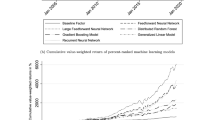Abstract
Selecting and estimating parsimonious models is often desired, but hard to achieve. This is particularly true when models can potentially contain a very large number of parameters but data are scarce—as is the case for many macro-economic models in general and interest-rate models in particular. These models need to cater for a large number of potential relationships and dependencies, but are fitted on low-frequency data to focus on the bigger picture and long-term effects. To identify the ideal model and estimating it is then particularly demanding from an optimization perspective. In this paper, we suggest an evolutionary approach that considers model selection and estimation simultaneously. Numerical experiments with artificial data suggest that the approach is well suited for this type of problem. In an empirical application for short-term and long-term interest rates denominated in US dollar, euro and the Japanese yen, respectively, parsimonious model structures are identified that highlight the dependencies as well as spill-overs across maturities and currencies.





Similar content being viewed by others
Notes
For general considerations on interest rates and the drivers behind bond prices, see, e.g., [3].
For a more detailed presentation of VEC and related models, see, e.g., [8] and the literature quoted therein.
For a more technical discussion of co-integration and its econometric implications, see [8].
For more details on the BIC and other Information criteria, see, e.g., [8].
Note that all indexed variables are redrawn in every generation; the generation subscript is dropped for the sake of improved readability.
[12] provide numerous experiments for typical benchmark problems.
All implementations where done on state-of-the-art desktop computers using the platform R, version 3.
For more details on the test and the econometric considerations, see, e.g., [8].
References
Brabazon A, O’Neill M, McGarraghy S (2015) Natural computing algorithms. Springer, Berlin
Brooks C, Burke SP, Persand G (2001) Benchmark and the accuracy of GARCH model estimation. Int J Forecast 17:45–56
Cecchetti SG, Schoenholtz KL (2011) Money, banking, and financial markets, global edition, 3rd edn. McGraw Hill, New York
Dornbusch R (1990) Real exchange rates and macroeconomics: a selective survey. Working paper 2775, National Bureau of Economic Research. http://www.nber.org/papers/w2775
Engle RF, Granger CWJ (1987) Co-integration and error correction: representation, estimation, and testing. Econometrica 55(2):251–76. http://ideas.repec.org/a/ecm/emetrp/v55y1987i2p251-76.html
Hastie T, Tibshirani R, Friedman J (2013) The elements of statistical learning: data mining, inference, and prediction, 2nd edn. Springer, Berlin. http://statweb.stanford.edu/~tibs/ElemStatLearn/, http://statweb.stanford.edu/~tibs/ElemStatLearn/
Juselius K (1993) Do purchasing power parity and uncovered interest rate parity hold in the long run?—an example of likelihood in a multivariate time-series model. Discussion papers 93–14, University of Copenhagen. Department of Economics http://ideas.repec.org/p/kud/kuiedp/9314.html
Lütkepohl H (2007) New introduction to multiple times series analysis, 2nd edn. Springer, Berlin
MacDonald R, Marsh I (1999) Exchange rate modelling. Advanced studies in theoretical and applied econometrics. Kluwer Academic Publishers, Dordrecht. http://books.google.de/books?id=qXeGe8wQvykC
McCullough B, Renfro C (1999) Benchmarks and software standards: a case study for GARCH procedures. Comput Econ Soc Meas 25:59–71
McCullough B, Wilson B (2005) On the accuracy of statistical procedures in Microsoft Excel 2003. Comput Stat Data Anal 49(4):1244–1252
Price KV, Storn RM, Lampinen JA (2005) Differential evolution. A practical approach to global optimization. Springer, Berlin
Storn R, Price K (1997) Differential evolution–a simple and efficient heuristic for global optimization over continuous spaces. J Glob Optim 11(4):341–359. doi:10.1023/A:1008202821328
Weber E (2006) British interest rate convergence between the US and europe: a recursive cointegration analysis. IUP J Monet Econ IV(4):29–47. http://EconPapers.repec.org/RePEc:icf:icfjmo:v:04:y:2006:i:4:p:29-47
Winker P (2001) Optimization heuristics in econometrics: applications of threshold accepting. Wiley, Chichester
Winker P, Maringer D (2004) New directions in macromodelling. In: Welfe A (ed) New directions in macromodeling. Chap optimal lag structure selection in VAR and VEC models, Elsevier, Amsterdam, pp 213–234
Winker P, Maringer D (2007) The threshold accepting optimisation algorithm in economics and statistics. In: Kontoghiorghes EJ, Gatu C (eds) Optimisation, econometric and financial analysis. Springer, Berlin, pp 107–125. doi:10.1007/3-540-36626-1-6
Winker P, Maringer D (2009) The convergence of estimators based on heuristics: theory and application to a GARCH model. Comput Stat 24(3):533–550. doi:10.1007/s00180-008-0145-5
Acknowledgments
We are grateful to the anonymous referees for their valuable comments and suggestions; to seminar and conference audiences in London, Klagenfurt, Geneva, and Lisbon for their feedback; to Peter Winker and Sandra Paterlini for discussions and inputs; and to the editors of this special issue for their encouragement and support.
Author information
Authors and Affiliations
Corresponding author
Rights and permissions
About this article
Cite this article
Maringer, D., Deininger, S.H.M. Selecting and estimating interest rate models with evolutionary methods. Evol. Intel. 9, 137–151 (2016). https://doi.org/10.1007/s12065-016-0145-2
Received:
Revised:
Accepted:
Published:
Issue Date:
DOI: https://doi.org/10.1007/s12065-016-0145-2




